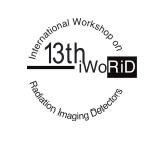Speaker
Ms
Frances Caroline Lopez
(Physics Department University of Trieste and INFN-Trieste, Italy)
Description
Purpose: One of the aims of the PICASSO (Phase Imaging for Clinical Application with Silicon detector and Synchrotron radiatiOn) project of INFN-Trieste is to develop a fast data acquisition system for a single photon counting silicon micro-strip detector. The PICASSO detector is designed in order to conform to the needs of imaging large in-vivo samples like breast in the case of mammography. The detector is expected to be fast, and with high efficiency with an aim of delivering a reasonably low dose at high spatial and contrast resolution.
Materials and Methods: The current PICASSO prototype comprises two layers of linear array of silicon microstrip sensors of 50 μm strip pitch, 300 μm sensor thickness, and 15mm depth. One layer has three modules, all coupled with MYTHEN II ASIC developed at PSI. Each strip is wire-bonded to MYTHEN II (total 4224 strips and 33 chips per module). PICASSO operates on single-photon counting mode with an “edge-on” configuration. The detector is linked to Picasso Control System, a printed circuit board which is based on an embedded Linux system (ELS). The ELS controls two FPGAs operating the detector with firmware so developed in order to perform fast and real time acquisition. The embedded Linux communicates with a client PC through a server-client architecture via TCP/IP over a standard 100Mbit Ethernet network.
Results: The new PICASSO electronics was tested at the SYRMEP beamline of Elettra on January and March 2011. Since both the detector and the beam have a laminar geometry, images are acquired by scanning the sample. Using PICASSO we obtained a frame rate up to 32 Hz at a 24-bit dynamic range. Mammographic test object images were acquired in order to study the effect on the spatial resolution of two different acquisition modalities: either continuous or step mode, within a range of scan steps. Using 100 m scan step significant effect in spatial resolution due to continuous scan, was noted at spatial frequencies higher than 4.5 lp/mm.
Conclusion: The detector has shown feasibility of a novel system that can be used for large in-vivo sample imaging. The first results with the new electronics suggest that it may be reasonably used for mammography. With further optimization, frame rate may still be increased by lowering the dynamic range, setting it to 16-bit for instance without a significant change with the hardware. PICASSO is in advanced realization phase: the measurements at SYRMEP are promising and clinical tests are foreseen.
Author
Ms
Frances Caroline Lopez
(Physics Department University of Trieste and INFN-Trieste, Italy)
Co-authors
Dr
Anna Bergamaschi
(SLS Detector Group, Paul Scherrer Institute)
Dr
Bernd Schmitt
(SLS Detector Group, Paul Scherrer Institute)
Dr
Diego Dreossi
(SYRMEP Group Sincrotrone Trieste S.C.p.A. Italy)
Prof.
Edoardo Castelli
(Physics Department University of Trieiste and INFN-Trieste, Italy)
Dr
Erik Vallazza
(INFN-Trieste, Italy)
Dr
Fulvia Arfelli
(Physics Department University of Trieste and INFN-Trieste, Italy)
Dr
Luigi Rigon
(INFN-Trieste, Italy)
Prof.
Renata Longo
(Physics Department University of Trieste and INFN-Trieste, Italy)
Dr
RongChang Chen
(INFN-Trieste, Italy)

